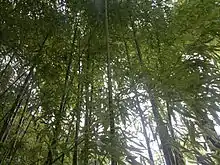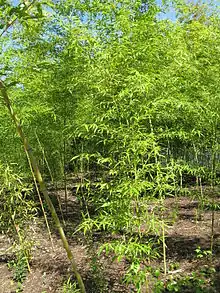Phyllostachys
Le genre Phyllostachys fait partie des Poaceae et regroupe plusieurs espèces de bambous. Ce sont pour nombre d'entre eux des bambous pouvant être cultivés jusqu'en Belgique.



(Phyllostachys edulis)
| Ordre | Poales |
|---|---|
| Famille | Poaceae |
Le genre Phyllostachys regroupe la plupart des espèces pouvant être trouvées en pépinière en Europe.
Description
Les Phyllostachys se caractérisent par 2 branches de taille inégale aux nœuds de leurs chaumes. Un sillon sur l'entre-nœud est également présent.
Les Phyllostachys ont un rhizome leptomorphe, ils sont donc traçants et peuvent être envahissants. C'est le cas notamment en Nouvelle-Calédonie[1], notamment l'espèce Phyllostachys flexuosa[2],[3].
Étymologie
Phyllo vient du grec ancien φύλλον, phýllon (« la feuille ») et stachys du grec stachus, épi. Le Phyllostachys est donc un grand épi à feuilles.
Liste des espèces et variétés
Selon World Checklist of Selected Plant Families (WCSP) (14 novembre 2016)[4] :
- Phyllostachys acuta C.D.Chu & C.S.Chao (1980)
- Phyllostachys acutiligula G.H.Lai (2013)
- Phyllostachys albidula N.X.Ma & W.Y.Zhang (2012)
- Phyllostachys angusta McClure (1945)
- Phyllostachys arcana McClure (1945)
- Phyllostachys atrovaginata C.S.Chao & H.Y.Chou (1980)
- Phyllostachys aurea (André) Rivière & C.Rivière (1878) (2-4 m) devient jaune lorsqu'il est au soleil.
- Phyllostachys aureosulcata McClure (1945)
- Phyllostachys bissetii McClure (1956)
- Phyllostachys carnea G.H.Ye & Z.P.Wang (1989)
- Phyllostachys circumpilis C.Y.Yao & S.Y.Chen (1980)
- Phyllostachys compar W.Y.Zhang & N.X.Ma (2012)
- Phyllostachys corrugata G.H.Lai (2013)
- Phyllostachys dulcis McClure (1945)
- Phyllostachys edulis (Carrière) J.Houz. (1906), bambou Moso ou bambou d'hiver
- Phyllostachys elegans McClure (1956)
- Phyllostachys fimbriligula T.H.Wen (1983)
- Phyllostachys flexuosa Rivière & C.Rivière, Bull. Soc. Acclim. France, sér. 3 (1878)
- Phyllostachys funhuaensis (X.G.Wang & Z.M.Lu) N.X.Ma & G.H.Lai, Bull. Bot. Res. (2001)
- Phyllostachys glabrata S.Y.Chen & C.Y.Yao (1980)
- Phyllostachys glauca McClure (1956)
- Phyllostachys heteroclada Oliv. (1894)
- Phyllostachys hirtivagina G.H.Lai (2013)
- Phyllostachys incarnata T.H.Wen, Bull. Bot. Res. (1982)
- Phyllostachys iridescens C.Y.Yao & S.Y.Chen (1980)
- Phyllostachys kwangsiensis W.Y.Hsiung, Q.H.Dai & J.K.Liu (1980)
- Phyllostachys lofushanensis C.P.Wang, C.H.Hu & G.H.Ye, J. Nanjing Univ. (1981)
- Phyllostachys longiciliata G.H.Lai (2013)
- Phyllostachys makinoi Hayata (1915)
- Phyllostachys mannii Gamble (1896)
- Phyllostachys meyeri McClure (1945)
- Phyllostachys microphylla G.H.Lai (2013)
- Phyllostachys nidularia Munro, Gard. Chron., n.s. (1876)
- Phyllostachys nigella T.H.Wen, Bull. Bot. Res. (1982)
- Phyllostachys nigra (Lodd. ex Lindl.) Munro (1868)
- variété Phyllostachys nigra var. henonis (Mitford) Rendle, J. Linn. Soc. (1904)
- variété Phyllostachys nigra var. nigra
- Phyllostachys nuda McClure (1945)
- Phyllostachys parvifolia C.D.Chu & H.Y.Chou (1980)
- Phyllostachys platyglossa C.P.Wang & Z.H.Yu (1980)
- Phyllostachys primotina T.H.Wen (1984)
- Phyllostachys prominens W.Y.Hsiung (1980)
- Phyllostachys propinqua McClure (1945)
- Phyllostachys purpureociliata G.H.Lai (2013)
- Phyllostachys reticulata (Rupr.) K.Koch (1873)
- Phyllostachys rivalis H.R.Zhao & A.T.Liu (1980)
- Phyllostachys robustiramea S.Y.Chen & C.Y.Yao (1980)
- Phyllostachys rubicunda T.H.Wen (1978)
- Phyllostachys rubromarginata McClure (1940)
- Phyllostachys rutila T.H.Wen, Bull. Bot. Res. (1982)
- Phyllostachys shuchengensis S.C.Li & S.H.Wu (1981)
- Phyllostachys stimulosa H.R.Zhao & A.T.Liu (1980)
- Phyllostachys sulphurea (Carrière) Rivière & C.Rivière (1878)
- Phyllostachys tianmuensis Z.P.Wang & N.X.Ma, J. Nanjing Univ. (1983)
- Phyllostachys varioauriculata S.C.Li & S.H.Wu (1981)
- Phyllostachys veitchiana Rendle, J. Linn. Soc. (1904)
- Phyllostachys verrucosa G.H.Ye & Z.P.Wang, J. Nanjing Univ. (1983)
- Phyllostachys violascens Rivière & C.Rivière, Bull. Soc. Acclim. France, sér. 3 (1878)
- Phyllostachys virella T.H.Wen, Bull. Bot. Res. (1982)
- Phyllostachys viridiglaucescens (Carrière) Rivière & C.Rivière (1878), bambou géant (10-12m) pouvant être utilisé comme haie, chaumes vert foncé. pouvant supporter -22 °C, diamètre jusqu'à 100mm, comestible et doux en goût
- Phyllostachys viridis R.A.Young & McClure
- Phyllostachys vivax McClure (1945)
- Phyllostachys yunhoensis S.Y.Chen & C.Y.Yao (1980)
- Phyllostachys zhejiangensis G.H.Lai (2013)
Cultivars
- Phyllostachys bambusoides 'Castillonis', (8-10m) c'est le bambou géant qui supporte le mieux le calcaire. Ses chaumes sont jaunes rayés de vert.
- Phyllostachys bambusoides 'Castillonis Inversa'
- Phyllostachys nigra 'henonis' bambou géant, (10-12m) pouvant être utilisé comme haie, chaumes vert sombre.
- Phyllostachys nigra 'boryana' bambou géant, (10-12m) pouvant être utilisé comme haie, chaumes vert tacheté.
- Phyllostachys pubescens heterocycla 'Kikko', variété relativement rare présentant des nœuds obliques, ce qui lui vaut son nom de Kikko (écaille de tortue)
- Phyllostachys vivax 'aureocaulis', (10-14m) identique au vivax mais aux chaumes de couleur jaune, cultivar instable pouvant avoir des lignes vertes, voire devenant complètement vert.
- Phyllostachys vivax 'huanwenzhu', (10-14m) identique au vivax mais aux chaumes de couleur vert clair rayés de jaune, cultivar stable.
Notes et références
- Groupe espèces envahissantes, Plantes envahissantes pour les milieux naturels de Nouvelle-Calédonie, Nouméa, Agence pour la prévention et l'indemnisation des calamités agricoles ou naturelles (APICAN), , 222 p., pp. 44-45
- Bernard Suprin, Mille et une plantes en Nouvelle-Calédonie, Nouméa, Editions Photosynthèse, , 382 p. (ISBN 9782952731638), p. 62
- Vanessa Hequet, Mickaël Le Corre, Frédéric Rigault, Vincent Blanfort, Les espèces exotiques envahissantes de Nouvelle-Calédonie, IRD, Institut de Recherche pour le Développement, , 87 p. (lire en ligne), p. 17, p. 33
- WCSP. World Checklist of Selected Plant Families. Facilitated by the Royal Botanic Gardens, Kew. Published on the Internet ; http://wcsp.science.kew.org/, consulté le 14 novembre 2016
Voir aussi
Articles connexes
Liens externes
- (en) Référence Catalogue of Life : Phyllostachys (consulté le )
- (en) Référence Flora of China : Phyllostachys (consulté le )
- (en) Référence Madagascar Catalogue : Phyllostachys (consulté le )
- (en) Référence Flora of Missouri : Phyllostachys (consulté le )
- (en) Référence FloraBase (Australie-Occidentale) : classification Phyllostachys
- (en) Référence GRIN : genre Phyllostachys Siebold et Zucc. (+liste d'espèces contenant des synonymes)
- (fr+en) Référence ITIS : Phyllostachys Sieb. et Zucc.
- (en) Référence Kew Garden World Checklist : Phyllostachys Siebold & Zucc. (1843) (consulté le )
- (en) Référence NCBI : Phyllostachys (taxons inclus)
- (fr) Référence Tela Botanica (France métro) : Phyllostachys
- (en) Référence The Plant List : Phyllostachys (consulté le )
- (en) Référence Tropicos : Phyllostachys Siebold & Zucc. (+ liste sous-taxons) (consulté le )
- (en) Référence uBio : Phyllostachys sp. (consulté le )
- (en) Référence UICN : taxon Phyllostachys (consulté le )
- Portail de la botanique
- Portail des Poaceae
- Portail de la Nouvelle-Calédonie